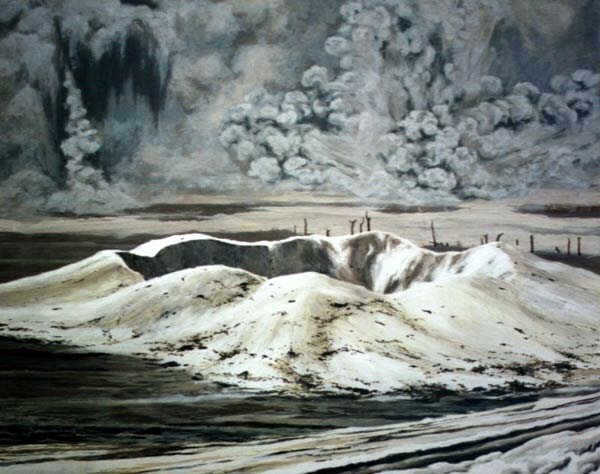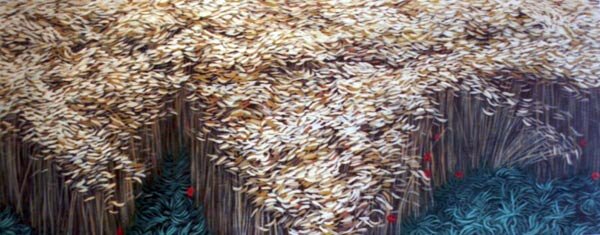 THE HERITAGE OF THE GREAT WAR
THE HERITAGE OF THE GREAT WAR

Salient - Landscapes of the Great War

La Boisselle, Northern France
Text and Paintings © by Sandy Grant
(Sandy Grant was born in Scotland in 1973. The artist currently lives and works in Glasgow)
This series of paintings portrays the violent and alien landscapes of the British held sector of the Western Front during the First World War.
The landscapes were derived from photographs and other sources, and I hope were presented in a context more accessible to contemporary minds than sepia photographs and museum exhibits.
The painting surface is 18mm MDF burned and covered with graphite to suggest blackened iron, alluding to the Industrial Revolution.
In the process of researching this exhibition I visited the villages and farmlands of the Ypres and Somme areas where the terrible fighting of WW1 took place. It is now a very beautiful place and it is difficult to imagine the hideous transformation it underwent between 1914 and 1918. Only occasionally did I 'realise' the past during my visit.
The landscape today is very similar to that previous to 1914 ie. quiet farmland, small market towns etc. The war years seem like a terrible disease from which the land has slowly recovered. It has not been 'cured' however. If you look closely its scars are seen everywhere, huge craters lie open to the sky and ghost like trench marks still zig-zag their way through ploughed fields.
Unexploded bombs are regularly recovered and they occasionally explode. Every year people are injured or worse. Someone once remarked to me that 'they are still digging up Roman coins so you can expect the war to produce for a long time to come'. There was such a concentration of heavy and prolonged bombing on this area that in some areas the contours of the landscape itself were changed beyond recognition.
I have been interested in, and researching WW 1 since 1998 when the final, state-organised Remembrance Day took place. In that time I have become quite familiar with the '14-'18 landscape so it was surprising to see it appearing as beautiful, healthy and productive agricultural land. At a glance all obvious traces of the war seem to have vanished except for the small pockets of no-mans land which still exist in the form of countless cemeteries of all sizes, containing tens to tens of thousands of graves.
There are many accounts with very lucid descriptions of the landscapes we created during the war, miles and miles of blasted earth and burned soil, poisoned, bombed and shattered over and over again. Not a tree left standing or a blade of grass growing - in short lifeless. More like the Martian or Lunar landscapes we are now so familiar with than France or Belgium.
This is a contemporary analogy of the resulting landscape, unforeseen by the participants in the war, but to me the similarities are very striking.
 Click on a small photo below - and you'll get the full picture.
Click on a small photo below - and you'll get the full picture.
 Or click here for a slide show.
Or click here for a slide show.

|
|
Lochnagar
Loch Nagar is also the name of a mountain in Scotland.
The painting shows the start of the infamous Battle of the Somme on 1st July 1916. The battle began with the detonation of a series of 17 mines. Some of the immense craters, such as the Lochnagar Crater, are still visible today.
At the end of this socalled First Day of the Somme 58,000 British troops were lost (one third of them killed), which to this day remains a one-day record. The battle ran on until 18 November, at which point it was called off.
|

|
|
Messines
Shell holes and craters and ditches and trenches filled with treacherous mud and water.
Messines, south of Ypres (Belgium) saw endless and hopeless fighting. Finally, in June 1917, the allies succesfully captured the area from the Germans. Nineteen mines were detonated in tunnels digged deep under the German strongholds. Some 10,000 men were killed during the explosion alone.
|

|
|
Mametz
The attack on Mametz Wood on 7 July 1916 was suicide.
Seven days into the battle of the Somme, the men of the 38th (Welsh) Division were directed to capture the formidable Mametz Wood, advancing suicidally uphill over open ground against sweeping machine gun and intense artillery fire. The attacks, ending on 12 July in the clearance of the wood, saw vicious hand-to-hand fighting and innumerable acts of courage - and over 4,000 Welsh deaths and casualties.
|

|
|
Passchendaele
The most controversial battle of the Great War was the third major battle of Ypres, better known as the Battle of Passchendaele. It took place between July and November, 1917.
The British and Empire forces advanced just five miles, at a cost of at least a quarter of a million casualties. Their one consolation was that the Germans had also suffered grievously.
Perhaps the battle's enduring epitaph is the phrase from one of Siegfried Sassoon's poems: I died in hell - They called it Passchendaele.
|

|
|
Thiepval
The pattern of death, drawn by white chalk that came out of the trenches and the shell holes.
Nowadays Thiepval is the place of a huge memorial, with white stone panels on which are inscribed over 73,000 names of both British and French soldiers who were killed in the Somme Battlefield between 1916-1917, and who have no known graves.
|

|
|
Zonnebeke
Zonnebeke, in Flanders, was the place where the first trenches in the Ypres Salient were dug, between 16th and 20th October 1914.
From that moment on it was living hell. The village was completely removed from the earth - and so were many men and boys.
|

|
|
Moquet Farm
The Battle of Mouquet Farm was one of the most tragic Australian experiences of 1914-18 on the Western Front.
The battle was part of the Somme Campaign and lasted from the beginning of August 1916 until September. It fell only after the British had seized Thiepval and swept past Mouquet Farm.
It was also the place where one of the youngest Australians died. Private Stanley Adams from Randwick, Sydney, was a plumber before the war. He was 16 years old when he was killed in action at Moquet Farm, in August 1916. He has no known grave.
|

|
|
Langemark
Langemark became the grave of numerous German boy soldiers. About 15% of Germany's volunteers were students and high school graduates. Entire lecture-rooms and classes - together with professors and teachers - would take themselves down to the recruiting offices.
In 1914 during the 1st Battle of Ypres, the German Army hurled these units of enthusiastic but untrained students into the fray. They were shot down in thousands by the only professional Army in Europe - the British.
|

|
|
German war cemetery at Langemark
This large German cemetery is only seven miles from Ypres. Many of the boy soldiers mentioned above lie here and for this reason the cemetery is often known as the Studentenfriedhof - the Students Cemetery.
There are 44,292 German soldiers buried here. The cemetery also holds a mass grave, where roughly 25,000 soldiers lie.
|

|
|
French war cemetery at Notre Dame de Lorette
The memorial at Notre Dame de Lorette commemorates the bloody fighting in January - March 1915, in which the French infantry eventually held the line and more or less saved their country. A determined German attack initially penetrated the line, but in the end the Germans were driven back.
The cemetery has 20,000 white crosses, in remembrance of over 120,000 men from both sides who died in this sector.
|

|
|
Britisch war cemetery Tyne Cot
One of the largest and most impressive war cemeteries in Flanders is Tyne Cot, situated to the south of the village of Passendale.
The name 'Tyne Cot' was given because on the site of the present cemetery, a cottage used to stand. The British soldiers abbreviated the word cottage to 'Cot' and coupled it with the name of the river Tyne in Northern-England.
On this cemetery are 11.856 graves.
|
 To .
To .
 To the Contemporary Art page of The Heritage of the Great War.
To the Contemporary Art page of The Heritage of the Great War.
 To the frontpage of The Heritage of the Great War.
To the frontpage of The Heritage of the Great War.
![]() Click on a small photo below - and you'll get the full picture.
Click on a small photo below - and you'll get the full picture.![]() Or click here for a slide show.
Or click here for a slide show.![]() To .
To .![]() To the Contemporary Art page of The Heritage of the Great War.
To the Contemporary Art page of The Heritage of the Great War.![]() To the frontpage of The Heritage of the Great War.
To the frontpage of The Heritage of the Great War.